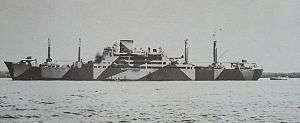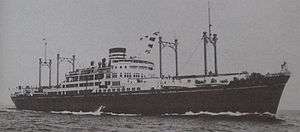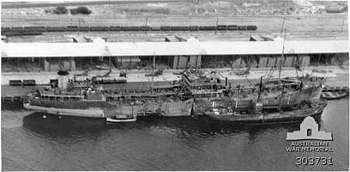Aikoku Maru (1940)
Aikoku Maru (愛国丸) was an armed merchant cruiser of the Imperial Japanese Navy in World War II. The ship entered service in 1940, the ship was later converted to an ammunition ship. She was destroyed in February 1944.
 Aikoku Maru in Singapore in 1942 | |
| History | |
|---|---|
| Name: | Aikoku Maru |
| Ordered: | 1937 fiscal year |
| Builder: | Mitsui Engineering & Shipbuilding, Tamano, Okayama, Japan |
| Laid down: | 29 December 1938 |
| Launched: | 25 April 1940 |
| Completed: | 31 August 1941 |
| Stricken: | 31 March 1944 |
| Fate: | Sunk by air attack, 16 February 1944 |
| General characteristics | |
| Type: | Armed merchant cruiser |
| Tonnage: | 10,438 grt |
| Length: | 160.8 m (527 ft 7 in) w/l |
| Beam: | 20.2 m (66 ft 3 in) |
| Draught: | 8.8 m (28 ft 10 in) |
| Propulsion: |
|
| Speed: | 20.9 knots (24.1 mph; 38.7 km/h) |
| Complement: | 133 |
| Armament: |
|
| Aircraft carried: | 1 × Kawanishi E7K floatplane |
| General characteristics (after 1942) | |
| Armament: |
|
| Aircraft carried: | 2 × Aichi E13A floatplanes |

Background
Aikoku Maru was laid down at the Mitsui Tamano shipyards in Okayama Prefecture on 29 December 1938. She was designed to be a combined passenger liner / cargo vessel for the Osaka Shosen Lines's regularly scheduled services to South America. Provisionally named Kyoto, the design for the new vessel was to have boasted of luxurious suite rooms. The vessel was built with large government subsidies provided from 1936 to encourage the production of large, high-speed transports and tankers, which could be quickly converted to military use in times of conflict. The vessel was launched on 25 April 1940, and was named Aikoku Maru at that time.
Design
Although ostensibly a luxury ocean liner, the military had a say in the design of Aikoku Maru with an eye towards its future use as a troop transport. Provision was made for landing craft and for the anchoring of naval artillery. The vessel measured 10,438 gross register tons,[1] with a length of 160.8 m (527 ft 7 in). Powered by two Mitsui B&W diesel engines with 13,000 shp (9,700 kW) driving twin screws, she was capable of 20.9 knots (24.1 mph; 38.7 km/h).
Operational history
Immediately on completion on 31 August 1941, Aikoku Maru was officially requisitioned by the Imperial Japanese Navy. She was converted into an armed merchant cruiser from 5 September while still at Tamano, with the installation of four 15 cm/50 41st Year Type guns, two QF 12 pounder 12 cwt naval guns, two Type 93 13.2-mm machine guns and two twin-mount 533-mm torpedo tubes. She was also fitted with powerful searchlights and boom for handling a Kawanishi E7K float plane (with one additional aircraft as a spare).
As an auxiliary cruiser and submarine tender
On 15 October 1941, the 24th Raider Squadron (CruDiv24), consisting of Aikoku Maru, Hōkoku Maru, and Kiyosumi Maru was created under the Combined Fleet. Aikoku Maru and her sister ship Hōkoku Maru were forward deployed to Jaluit Atoll in the Marshall Islands at the end of November in preparation for the upcoming hostilities against the United States.[2]
On 13 December 1941, Aikoku Maru and Hōkoku Maru sank SS Vincent (6210 GWT), an American merchant vessel with a cargo of rice from Australia to Panama at 22-41S, 118-19E. On December, the reconnaissance floatplane from Aikoku Maru spotted the American freighter Malama (3275 GWT) en route to Manila. The plane failed to return, and despite searching by both Japanese vessels, no trace was ever found of the missing aircraft. The second floatplane reacquired SS Malama south of the Cook Islands on 2 January 1942, and after making a strafing attack, orders the ship to stop. After the crew of Malama abandoned ship, she was sunk at 26-39S, 151-24W.[3] Aside from the missing pilot, there were no casualties on either side, and the sortie was concluded on 20 January. CruDiv24 returned to Hashirajima in February, after disembarking their 76 POWs at Oita.
On 14 February 1942, at Kure Naval Arsenal, Aikoku Maru's four 152-mm guns were replaced by eight 14 cm/50 3rd Year Type naval guns. She was also modified to carry submarine torpedoes in her hold to enable her to function as an auxiliary submarine tender. In this capacity, Aikoku Maru and Hōkoku Maru were deployed with the IJN 6th Fleet on 10 March to support submarine operations off the east coast of Africa and Mozambique. At the end of March, Aikoku Maru and Hōkoku Maru returned to Kure, where CruDiv24 was formally disbanded, and they are reassigned to Subron8, operating out of Penang from early April, supporting submarine operations in the western Indian Ocean.[4] On 9 May, Aikoku Maru captured the Dutch tanker Genota (7,897 GWT) 480 miles (770 km) SSE of Diego Suarez, Madagascar. On 5 June, she sank MV Elysia (6757 GWT), a British freighter carrying a number of Allied troops at 27-19S, 37-01E. On 12 July, she captured the New Zealand registered freighter Hauraki near Ceylon. She placed a prize crew on board, but en route back to Japan, her New Zealander engine crew managed to sabotage the cargo and engine spares.[2]
After repairs at Seletar Naval Base in Singapore, the floatplanes on Aikoku Maru were upgraded to two Aichi E13As, two dual Type 96 25 mm AT/AA Guns were added, and an additional 70 torpedoes were loaded. She continued to be based out of Penang until late August under the command of Tamotsu Oishi.
From September, Aikoku Maru was assigned to the IJN 8th Fleet and tasked with transporting the IJA 38th Infantry Division to Rabaul for the reinforcement of Guadalcanal. After accomplishing this mission by 10 October, her Commerce Raiding Unit was reactivated, and Aikoku Maru transited the Sunda Strait into the Indian Ocean on 7 November, together with Hōkoku Maru.[2]

On 11 November, the raiders attacked the Dutch tanker Ondina (6341 GWT), which was accompanied by the minesweeper HMIS Bengal southwest of the Cocos Islands. Hōkoku Maru was closer and attacked first, but a shot from Ondina's 4-in guns hit Hōkoku Maru's starboard torpedo tube, and detonated the torpedo. A fire broke out, which quickly raged out of control, causing the aft magazine to explode, sinking the vessel. Aikoku Maru then arrived, and drove off Bengal while Ondina also attempted to escape. Aikoku Maru scored six hits on Ondina with her guns, but her two torpedoes missed. However, with their ship damaged and out of ammunition, the crew of Ondina abandoned ship. Aikoku Maru rescued 278 survivors of Hōkoku Maru, and returned to Penang, and from there to Singapore and Rabaul. Meanwhile, the crew of Ondina managed to re-enter their ship and effect repairs, escaping to Fremantle, Australia.[5]
As a military transport
From 16 December 1942, Aikoku Maru was reassigned back to the IJN 8th Fleet, primarily as a military transport to support New Guinea operations, and her aircraft were disembarked. While unloading cargo at Madang on 18 December, she was attacked in an air raid by B-17 Flying Fortress bombers of the 43rd Bomb Group of the USAAF Fifth Air Force, but was not hit. She returned to Kure on 29 December 1942.[2]
As part of "Operation C" (the Reinforcement of New Guinea), on 5 January 1943, Aikoku Maru loaded the IJAAF 209th Airfield Battalion, 14th Aerial Repair Shop and others, a total of 691 men plus 34 vehicles at Pusan in Korea, arriving at Rabaul on 14 January. She was then sent to Tsingtao in Japanese-occupied China, arriving 24 January, and from there to Cebu (2 February) and Palau (7 February), where she loaded additional troops and cargo, delivering the reinforcements successfully to Wewak on 23 February. She returned to Kure on 5 April.[2]
On 10 July 1943, as part of a convoy including the aircraft carrier Un'yō, Aokoku Maru was attacked by the submarine USS Halibut 170 nautical miles (310 km; 200 mi) north of Truk, which fired six torpedoes. One struck Aikoku Maru, causing moderate damage. On her return voyage, on 15 July, she was attacked again, this time by the submarine USS Tinosa, whose four torpedoes all missed. She returned to Kure on 2 September.[2]
On 6 October, Aikoku Maru returned to Tamano for repairs and refitting with additional weaponry, which included two 152 mm guns and four twin-mount Type 96s. The refitting work was completed by 31 December 1943.

On 21 January 1944, Aikoku Maru loaded the 629 men of the 66th Naval Guard Unit, with ammunition, supplies and construction materials. The convoy was attacked 300 nautical miles (560 km; 350 mi) NW of Truk by the submarine USS Trigger, which sank the minelayer Nasami and transport Yasukuni Maru; however, Aikoku Maru was undamaged and reached Truk on 1 February. After making an abortive run to Brown Island, she returned to Truk on 16 February to find that most of the capital ships had evacuated the base in anticipation of an impending American attack. Aikoku Maru began loading ammunition and making preparations for departure to Rabaul, loading troops of the 1st Amphibious Brigade. However, before preparations were complete, Operation Hailstone began, with the US Navy Task Force 58 striking at Truk with 30 air strikes of over 150 aircraft each every hour for a period of two days. On the first day, 17 February 1944, Aikoku Maru was bombed by aircraft from the carrier USS Intrepid, with the first bomb exploding in the officer's wardroom, causing a fire. She was hit three more times in this attack, and was hit again in the second attack by a torpedo which set off the ammunition in her No.1 hold, shearing off the bow. Aikoku Maru sank in two minutes at 07°22′N 151°56′E, with most of the 945 crew and passengers.[2] The aircraft which dropped the torpedo on Aikoku Maru- a TBM Avenger and its three-man crew from Torpedo Squadron 6 were also destroyed in the explosion of the ship.[6]
Aikoku Maru was removed from the navy list on 30 March 1944.
Shipwreck
The wreck of Aikoku Maru is a popular scuba diving spot in the waters of Truk Lagoon, despite her depth of approximately 64 metres (210 ft). The wreck is upright, with the bridge at the 40 metres (130 ft) meter level and deck extending approximately 10 meters deeper. The remains of an anti-aircraft gun on top of the aft deckhouse is often photographed, as are the scattered dishes and kitchen utensils in her galley. Her wreck was first dived by the famous French explorer Jacques-Yves Cousteau in 1969, but she was not positively identified until later. In July 1980, a Japanese recovery team retrieved the remains of approximately 400 men who were killed in the attack, but the remains of hundreds more remain on site.[7]
On February 17, 1994, a memorial monument was placed on deck at approximately 125 feet. The monument was a joint of the Chuuk Visitors Bureau, US Air Force Civic Action (CAT) Team, The S.S. Thorfinn and Blue Lagoon dive shop.[8]
Notes
- Lindemann, p. 145
- CombinedFleet.com: Aikoku Maru Tabular Record of Movement;
- Cressman, The Official Chronology of the U.S. Navy in World War II; page 68
- Boyd, The Japanese Submarine Force and World War II; page 90
- Visser, Jan (1999–2000). "The Ondina Story". Forgotten Campaign: The Dutch East Indies Campaign 1941–1942. Archived from the original on 21 March 2011.
- Pacific Wrecks
- Jackson, Top Wreck Dives of the World; page 127
- Larry McLean, S.S. Thorfinn Crew and monument placer
References
- Bailey, Dan E. (1992). World War II: Wrecks of the Kwajalein and Truk Lagoons. North Valley Diver Publications. ISBN 0-911615-05-9.
- Boyd, Carl (2002). The Japanese Submarine Force and World War II. Naval Institute Press. ISBN 1557500150.
- Cressman, Robert (1999). The Official Chronology of the U.S. Navy in World War II. Naval Institute Press. ISBN 1557501491.
- Gardner, Robert (1985). Conway's All the World's Fighting Ships, 1906–1921. Conway Marine Press. ISBN 0851772455.
- Jackson, Jack (2007). Top Wreck Dives of the World. New Holland Publishers. ISBN 1845374665.
- Lindemann, Klaus (2005). Hailstorm Over Truk Lagoon: Operations Against Truk by Carrier Task Force 58, 17 and 18 February 1944, and the Shipwrecks of World War II. Oregon, USA: Resource Publications. ISBN 1-59752-347-X.
- Morison, Samuel Eliot (1961). Aleutians, Gilberts and Marshalls, June 1942 – April 1944, History of United States Naval Operations in World War II. Boston: Little, Brown and Company. ASIN B0007FBB8I.CS1 maint: ref=harv (link)
- Stewart, William Herman (1986). Ghost Fleet of the Truk Lagoon: An Account of "Operation Hailstone", February, 1944. Pictorial Histories. ISBN 0-933126-66-2.
External links
- Parshall, Jon; Bob Hackett; Sander Kingsepp; Allyn Nevitt. "CombinedFleet.com: Aikoku Maru Tabular Record of Movement".